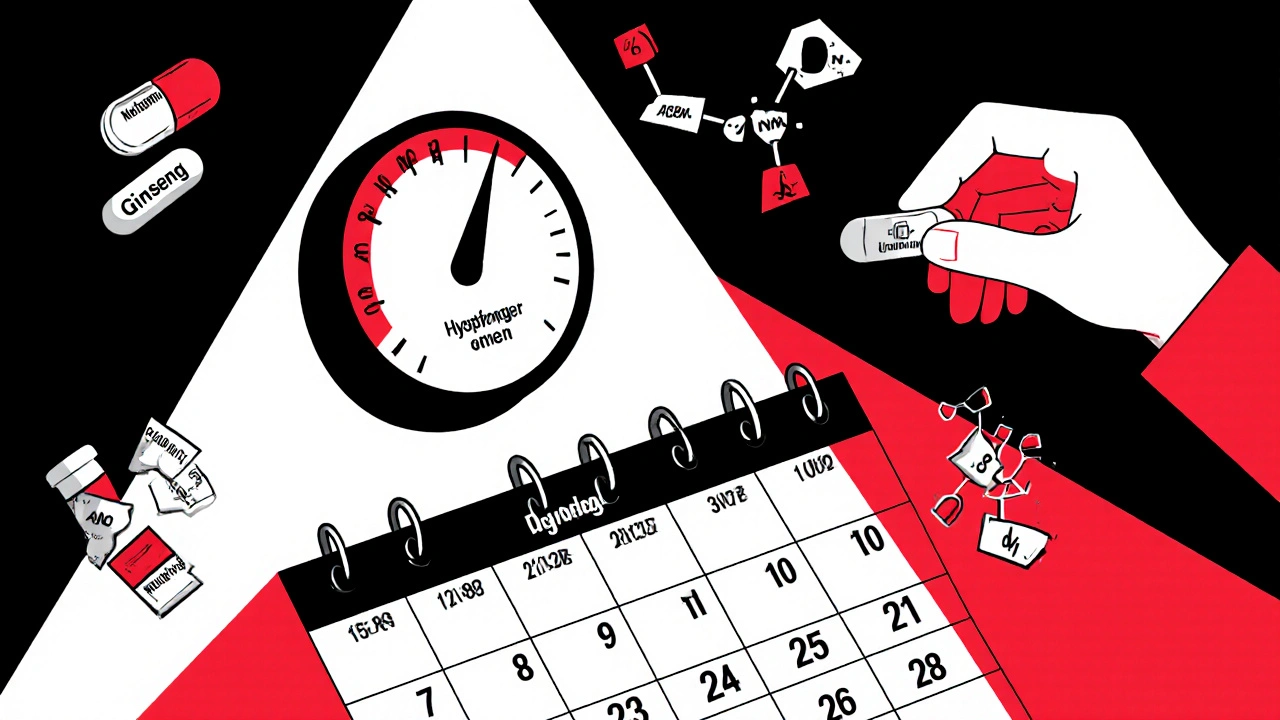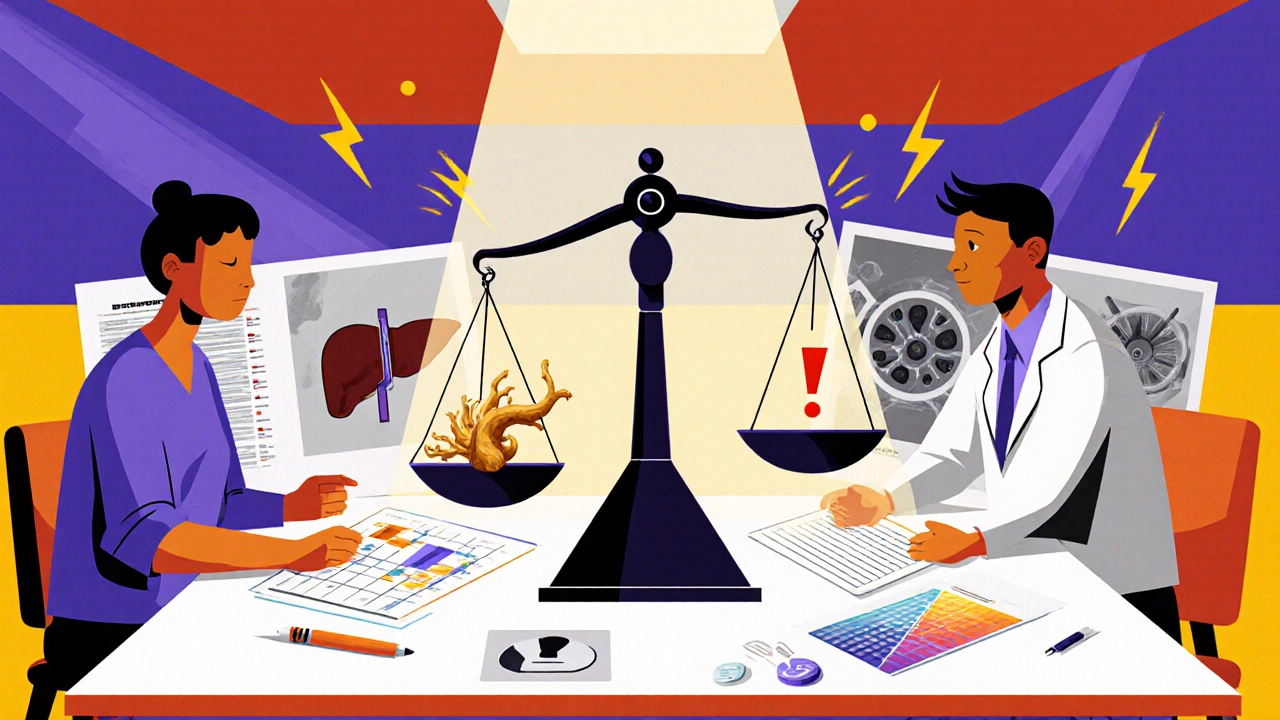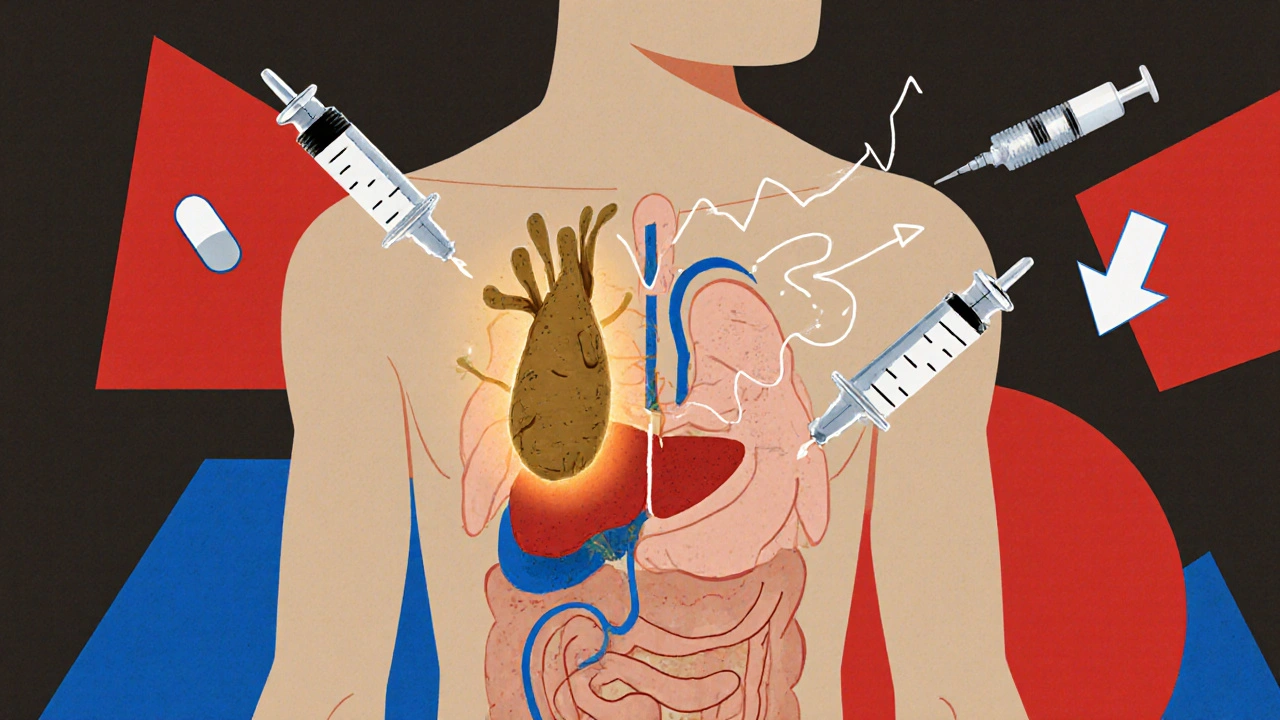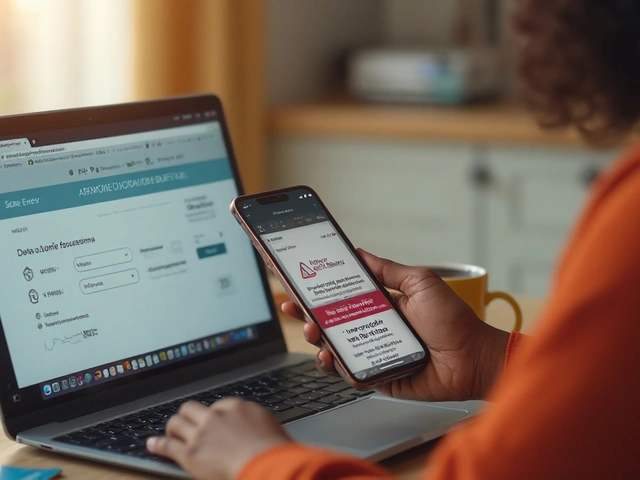Ginseng & Diabetes Medication Risk Calculator
Potential Interaction Risk
What this means:
Low risk: Blood sugar is stable but may need monitoring
Medium risk: Potential for hypoglycemia, requires careful monitoring
High risk: Significant danger of severe hypoglycemia, consult doctor immediately
Your Personalized Monitoring Plan
Important Safety Note: This calculator estimates risk based on current medical knowledge. It does not replace medical advice.
When you’re managing type 2 diabetes, every supplement you take matters-especially one as widely used as ginseng. It’s been around for centuries in traditional medicine, and now, modern research shows it might help lower blood sugar. But here’s the catch: if you’re already on insulin or oral diabetes meds like metformin or glipizide, ginseng could push your blood sugar too low. That’s not just inconvenient-it’s dangerous.
How Ginseng Affects Blood Sugar
Ginseng, especially Asian ginseng (Panax ginseng) and American ginseng (Panax quinquefolius), contains active compounds called ginsenosides. These aren’t just plant chemicals-they directly influence how your body handles glucose. Studies show they help your pancreas release insulin more efficiently, improve how your cells take in glucose, and reduce insulin resistance. One 12-week study with 74 people with type 2 diabetes found that taking 3 grams of American ginseng daily lowered fasting blood sugar by 0.71 mmol/L compared to placebo. That’s a measurable drop.
But here’s what most people don’t realize: ginseng doesn’t just lower blood sugar. It can make your diabetes medications work harder than they’re supposed to. Think of it like turning up the volume on a song you’re already listening to at full blast. The result? Too much of a good thing.
The Risk: Too Much Lowering, Too Fast
Diabetes medications are carefully dosed to keep blood sugar in a safe range-usually between 4 and 7 mmol/L fasting. If you add ginseng on top of insulin, sulfonylureas, or even SGLT2 inhibitors, you’re stacking blood sugar-lowering effects. That increases your risk of hypoglycemia: dizziness, shaking, sweating, confusion, or worse-passing out.
WebMD, the Cleveland Clinic, and the Merck Manual all warn about this. The Merck Manual specifically says ginseng interacts with “medications that decrease blood sugar levels.” The American Academy of Family Physicians (AAFP) has flagged this interaction since 2003, advising caution with oral hypoglycemics and insulin. It’s not speculation-it’s documented.
And it’s not just about dosage. One person might take 200 mg of standardized extract, another might chew a slice of dried root. The amount of ginsenosides varies wildly depending on the product, the growing conditions, and how it’s processed. There’s no standardization in supplements. One bottle might have 5% ginsenosides; another might have 12%. You can’t assume consistency.
What You Need to Monitor
If you’re taking ginseng and diabetes meds, you can’t just check your blood sugar once a day. You need to check more often-especially in the first few weeks.
- Check fasting blood sugar every morning before eating
- Test 2 hours after meals to see how your body responds
- Monitor before bed if you’re on nighttime insulin or sulfonylureas
- Pay attention to symptoms: sweating, heart palpitations, blurred vision, or sudden fatigue
Medical News Today recommends reporting any unusual results to your doctor. That’s not a suggestion-it’s a safety requirement. Your doctor may need to reduce your insulin dose or switch your oral medication. A 10% reduction in metformin or glimepiride might be enough to prevent lows when adding ginseng.

Not All Ginseng Is the Same
There’s a big difference between American ginseng, Asian ginseng, and Siberian ginseng. Siberian ginseng (Eleutherococcus senticosus) isn’t even true ginseng-it’s a different plant entirely. And while American and Asian ginseng tend to lower blood sugar, Siberian ginseng can do the opposite: raise it. That’s why product labels matter.
Check the scientific name on the bottle. If it says Panax ginseng or Panax quinquefolius, you’re dealing with the real thing. If it just says “Siberian ginseng,” it won’t have the same effect-and might even mess with your control.
Also avoid liquid forms unless they’re sugar-free. Many ginseng tinctures and syrups contain added sugar or alcohol, which defeats the purpose and can spike your glucose. Stick to capsules or dried root.
Other Medications You Need to Watch For
Diabetes doesn’t live in isolation. Most people with type 2 diabetes also take meds for high blood pressure, cholesterol, or joint pain. Ginseng doesn’t just play nice with diabetes drugs-it can interfere with others too.
- Blood thinners: Ginseng may increase bleeding risk when taken with aspirin, warfarin, or NSAIDs like ibuprofen.
- Antidepressants: It can interact with MAO inhibitors, causing dangerous spikes in blood pressure.
- Corticosteroids: Ginseng may reduce their effectiveness.
- Cancer drugs: Some studies suggest it affects how imatinib and raltegravir are processed by the liver, raising the risk of toxicity.
If you’re on more than two medications, talk to your pharmacist before adding ginseng. They can run a drug interaction check in seconds.

What the Research Really Says
Yes, ginseng shows promise. But let’s be clear: the evidence isn’t strong enough to call it a treatment. Most studies involved fewer than 100 people and lasted only 4 to 12 weeks. That’s not enough to know what happens over years. There’s no long-term data on kidney or liver safety with daily use.
The AAFP calls its effect on blood sugar “modest” and the evidence “limited.” That’s not a dismissal-it’s a warning to proceed carefully. It’s not a magic pill. It’s a tool that can help, but only if used under supervision.
One study did find no negative effects on liver enzymes (AST, ALT) or kidney markers (creatinine) in diabetic patients taking ginseng. That’s reassuring. But again-it was a short-term study. We don’t know what happens after 5 years of daily use.
Should You Take It?
If you’re thinking about trying ginseng, here’s the real answer:
- Don’t start without talking to your doctor.
- Don’t replace your diabetes meds with ginseng.
- Start low: 100-200 mg of standardized extract per day.
- Check your blood sugar 3-4 times a day for the first 2 weeks.
- Keep a log: note your readings, what you ate, your meds, and when you took ginseng.
- Stop immediately if you have symptoms of low blood sugar.
It’s not about avoiding ginseng. It’s about using it wisely. For some people, it helps with energy, inflammation, and blood sugar control. For others, it causes trouble. The difference? Awareness. Monitoring. Communication.
Bottom Line
Ginseng isn’t a cure. It’s a supplement with real biological effects-and real risks when mixed with diabetes meds. The data shows it can lower blood sugar. The warnings show it can lower it too far. The solution isn’t to avoid it entirely. It’s to use it with precision, under medical supervision, and with constant monitoring.
If you’re already taking insulin or oral diabetes drugs, ginseng isn’t something to try on a whim. It’s something to plan for-with your doctor, your glucose meter, and your health history front and center.
Can ginseng replace my diabetes medication?
No. Ginseng may help lower blood sugar slightly, but it’s not strong or reliable enough to replace insulin or oral diabetes medications. Stopping your prescribed meds to use ginseng alone can lead to dangerously high blood sugar and long-term complications. Always use ginseng as an add-on, not a substitute.
How long does it take for ginseng to lower blood sugar?
In clinical studies, effects were seen within 4 weeks, with the most consistent results after 8-12 weeks of daily use. However, individual responses vary. Some people notice changes in energy or appetite sooner, but measurable drops in blood sugar usually take at least a month. Monitor closely during this time.
Is American ginseng better than Asian ginseng for diabetes?
Research suggests American ginseng (Panax quinquefolius) has a more consistent blood sugar-lowering effect than Asian ginseng. One study showed American ginseng reduced fasting glucose by 0.71 mmol/L, while Asian ginseng showed more variable results. However, both types contain ginsenosides and can interact with diabetes meds. Stick to American ginseng if your goal is blood sugar support.
Can I take ginseng with metformin?
Yes, but with caution. Both metformin and ginseng lower blood sugar. Taking them together increases the risk of hypoglycemia. If you take both, check your blood sugar more often-especially before meals and at bedtime. Your doctor may need to reduce your metformin dose slightly. Never adjust your metformin on your own.
What’s the safest way to take ginseng with diabetes?
Start with 100-200 mg of standardized American ginseng extract once daily. Take it in the morning with food. Avoid liquid forms with added sugar. Check your blood sugar 3-4 times a day for the first 2 weeks. Keep a log and share it with your doctor. Stop immediately if you feel dizzy, shaky, or confused. Always consult your provider before starting.






Man, I’ve been taking American ginseng for months now with my metformin and honestly? I didn’t realize how much it was helping until I skipped a day and my morning sugars spiked. Now I check twice a day and keep a little log in my phone. It’s not magic, but it’s a solid helper if you’re smart about it.
November 10Ryan Masuga